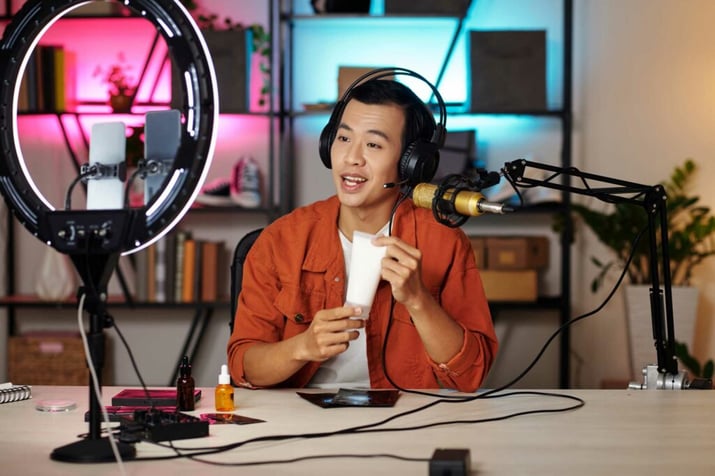It goes without saying that cosmetics campaigns rely heavily on the business of looking good. But what about the business of smelling good? Coty and other major cosmetics beauty brands like Yves St. Laurent and Dior are willing to bet and bet big that the fragrance industry is as strong as ever. Coty CEO Sue Nabi recently elaborated that “[even] in an environment where people are constrained…what’s happening is that this kind of little luxury is something people are not ready to give up on.” And while news of pleasantly-scented commuters may bring a smile to the faces of the bridge-and-tunnel crowd, Nabi is right.
Fragrances have been featured in major beauty ad campaigns for over a century, starting with poster advertisements in the early 1900s. Fast forward to the ’90s, and television perfume creatives had practically become their own film genre depicting sometimes abstract but always aspirational stories that could best be summed up as “a mood.” Look no further than Coty brand partner Burberry who has certainly seen viral success from TV creatives exploring this theme.
But it’s not just the moves in front of the camera earning beauty brands consumer engagement. Coty recently introduced the first globally marketed fragrance made with alcohol manufactured from recycled carbon emissions, reflecting the growing interests of a consumer base increasingly focused on self-care, sustainability, and a focus on the very ingredients that elevate their natural beauty.
In today’s category and brand spotlight, we go beyond surface-level beauty to examine the messaging and the high-value ingredients behind the beauty industry’s most engaging marketing strategy. We also discuss the opportunities that lay ahead for Coty and other emerging and legacy cosmetic brands battling for consumer engagement.
The Power of One: Effective Beauty Ads Embrace Simplicity
In recent years, a consistent trend across the Cosmetics category in TV advertising has been one of individual product promotion. All but one Cosmetics category creative to air this year has promoted an individual makeup product, whether that be L’Oreal’s true match foundation, Revlon’s suede ink lipstick, Charlotte Tilbury’s matte beauty blush wands, or e.l.f.’s power grip primer.
The only cosmetics brand to showcase a creative promoting multiple products? Coty’s COVERGIRL.
COVERGIRL’s multi-product ad campaign for Simply Ageless :15 underperformed compared to its single-product variants. And although the ad featured model Niki Taylor and promoted the brand’s triple-threat mascara, foundation, and concealer combo, the ad was ultimately 10% less engaging than the average COVERGIRL ad.
In contrast, versions advertising only the concealer or only the foundation were more effective in driving audience engagement for the brand.
Charlotte Tilbury tried its hand at multi-product promotion creatives when it launched its national TV debut in 2021 and shifted to creatives with a single product focus in Q1 2023. The marketing strategy paid off as the brand’s new creatives significantly outperformed the brand’s 2021-2022 creatives promoting multiple products, such as Gift Love :15. Among Charlotte Tilbury’s four new creatives in 2023, Hollywood Glow Glide Highlighter :15 has been the most effective, outperforming the brand’s average ad by 18%.
The reflection we see here mirrors consumers’ purchasing patterns in this category, as they selectively embrace the products that most easily complement their life and daily routines.
Inside The World of Ingredient-Centric Beauty Ads
Today’s consumers increasingly see health, well-being, and self-care purchases as needs instead of wants. In turn, they’ve increasingly educated themselves about personal care products and are paying closer attention than ever to the means and methods that make all the difference in their lives. Along with this focus comes an increased interest in the active ingredients in beauty products that power their daily routines, like skincare, makeup, and fragrances.
Perhaps no one knows this better than L’Oréal subsidiary CeraVe. Creatives that shout out CeraVe’s ceramide-rich formula have been 20% more effective than the average body and skin care ad at generating viewer engagement. L’Oréal has also gotten in on this shift with the ingredient-first messaging around its true match nude tinted serum boasting its 1% hyaluronic acid. This ad was 12% more effective at engaging viewers than the average L’Oréal ad in the past year.
Beauty brand Revlon has also successfully driven audience engagement with ingredient-first creatives. In February 2023, the brand launched an ad highlighting its Illuminance foundation with hyaluronic acid and 5% squalene. To date, it’s the top-performing Revlon ad of the year.
This trend also holds true for marketing across prestige brands. Charlotte Tilbury launched a 15-second creative for its Magic Cream Moisturizer featuring a dermatologist’s message this year. The doctor lists the formula’s notable ingredients, including vitamins C and E, hyaluronic acid, and peptides. So far, the Magic Cream Moisturizer creative has outperformed the brand’s average ad by 7%.
The popularity of ingredients-focused creatives among viewers teaches us that brand names alone no longer drive consumer engagement. This, coupled with influencers on social media platforms like TikTok and pandemic-amplified wellness trends, has heightened the demand for clean beauty products that marry the benefits and features of skincare and makeup. And brands, both legacy and emerging, should seek to capitalize on these evolving trends.
TV Ad Engagement in the Age of the Influencer

With the rise of new-wave cosmetics brands, influencer-based digital advertising is becoming more prevalent than traditional TV ads. Many of these brands implement a direct-to-consumer model and connect online campaigns to their online storefronts, resulting in great success. Meanwhile, legacy cosmetics brands like Coty, L’Oréal, and Revlon have adapted by creating online creatives to cater to a younger consumer base.
However, TV advertising for the category isn’t going anywhere. Despite a decrease in media weight this year, the Cosmetics category observed a 16% increase in engagement volume as a result of higher per-person engagement.
In fact, within the Cosmetics category, Il Makiage, Charlotte Tilbury, and e.l.f. have been the most effective in terms of generating viewer engagement via TV creatives. And four major legacy brands, including Coty company COVERGIRL and competitors Revlon, Maybelline, and L’Oréal, accounted for 78% of the national TV ad spend in the Cosmetics category year to date. This has all resulted in engagement with ads in the Cosmetics category, year to date, to be up by 9% compared to engagement over the previous four months.
This means that now is a great time to build on that investment by refining creatives to align with consumer needs. For brands of all sizes, now is the time to show off their history of fearless innovation and product development and to put them in front of consumers ready to engage with them.
Little Luxuries, Big Potential
The beauty and cosmetics industry has witnessed the evident adoption of the philosophy of “it’s the little things that count.” From a singular focus on product to beneficial ingredients, the results speak for themselves. Today’s consumers gravitate toward subtle yet chic indulgence and aren’t shy to spend on it. The key to capturing their attention and driving increased engagement is crafting creatives that make it easier for consumers to imagine these products in their daily lives.
But the journey doesn’t end there. The foundation of a forward-thinking brand is built on knowing what works. Whether you run a major legacy brand like Coty or an upstart, digitally native cosmetics company, you can’t drive high engagement with your TV creatives and customers if you don’t have high-quality, real-time data. If you want to change up a prospective customer’s routine, it may be time to change up yours.
Contact us today to learn all about the powerful ingredients that provide your brand with the outcomes that matter.

